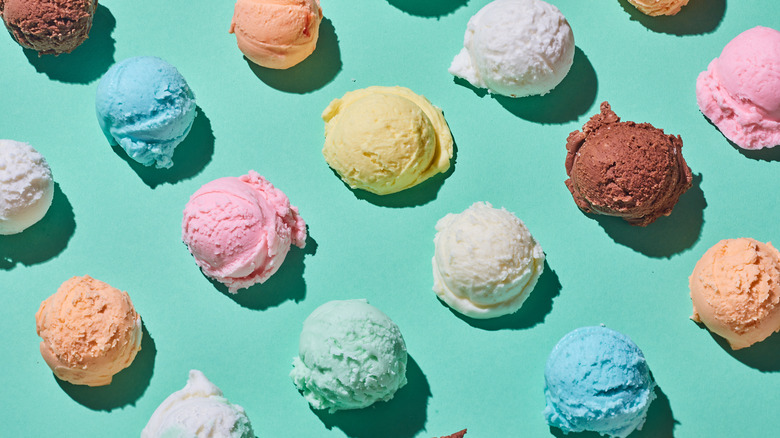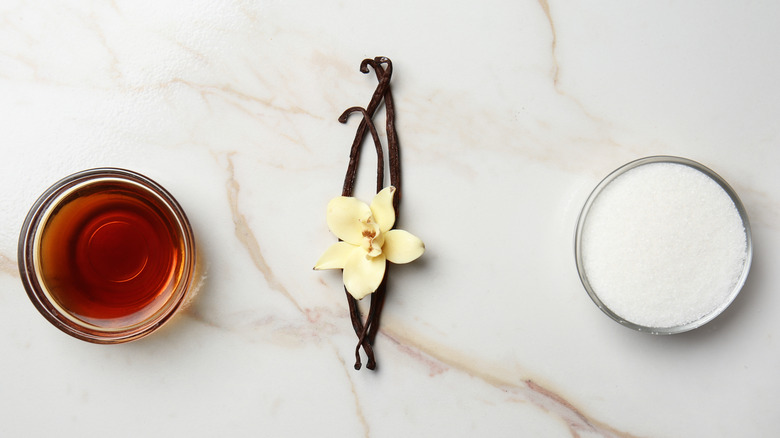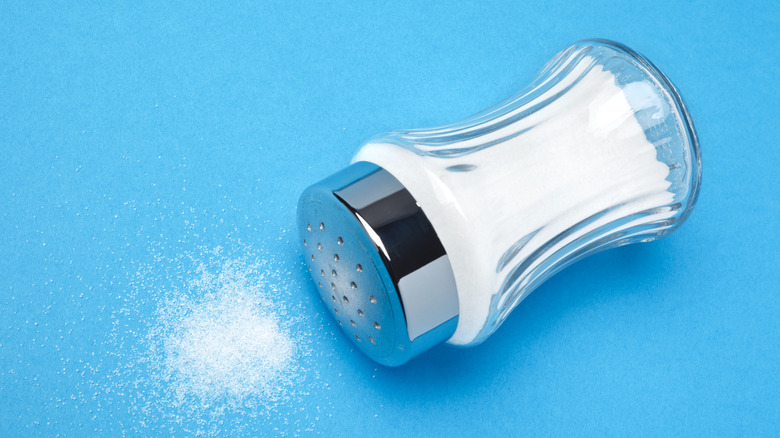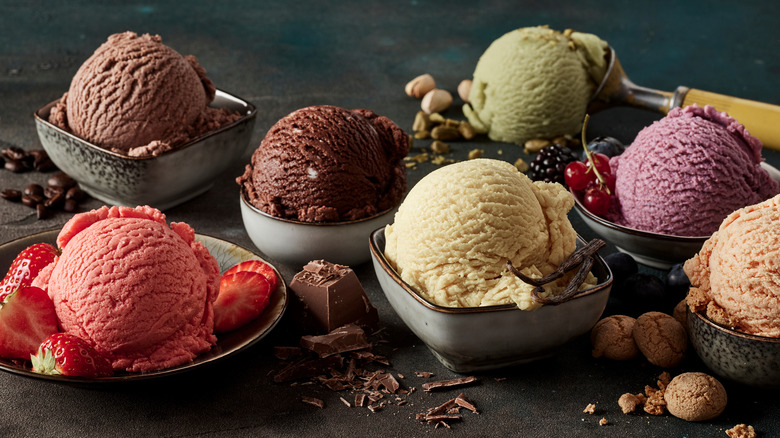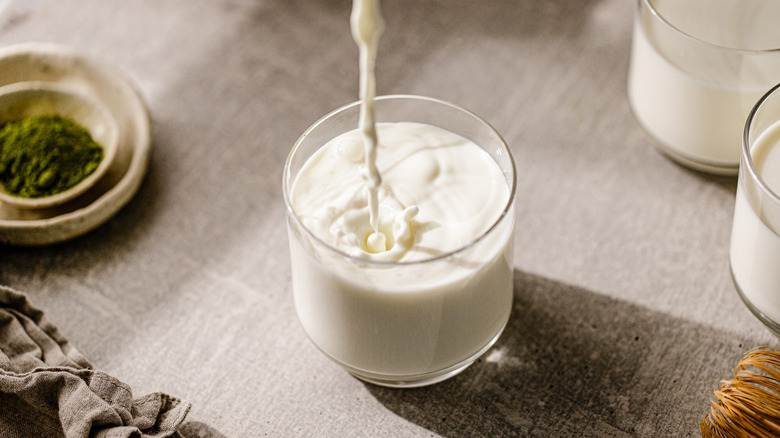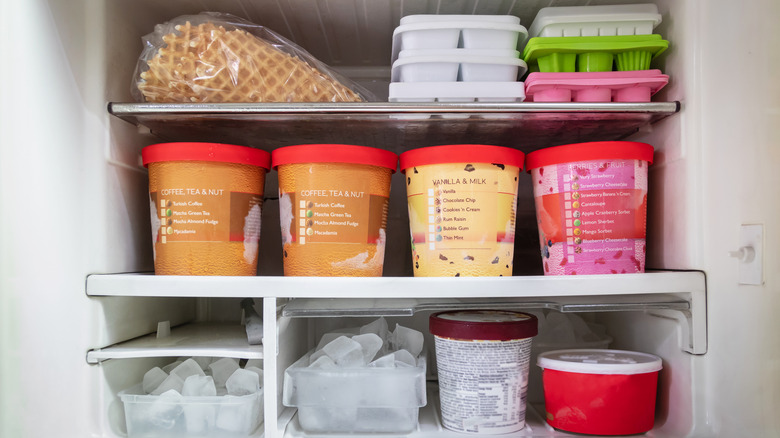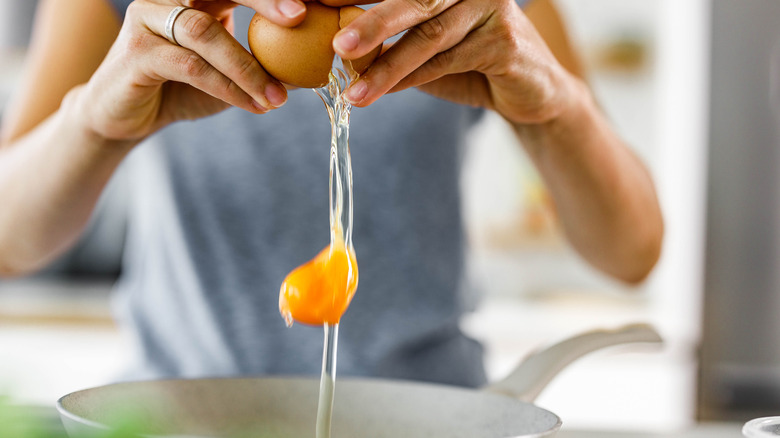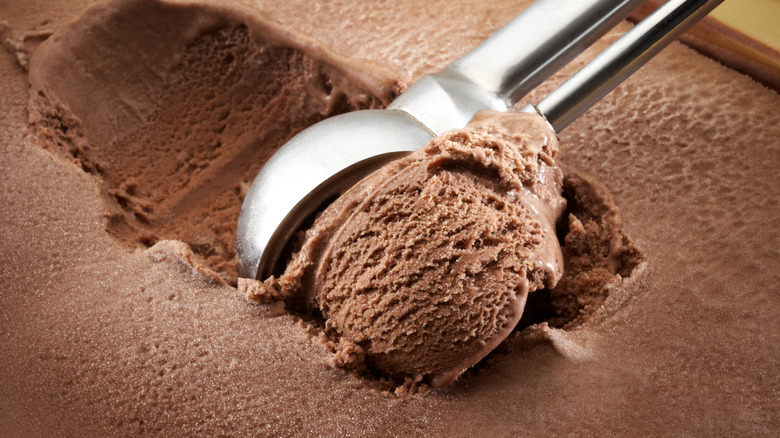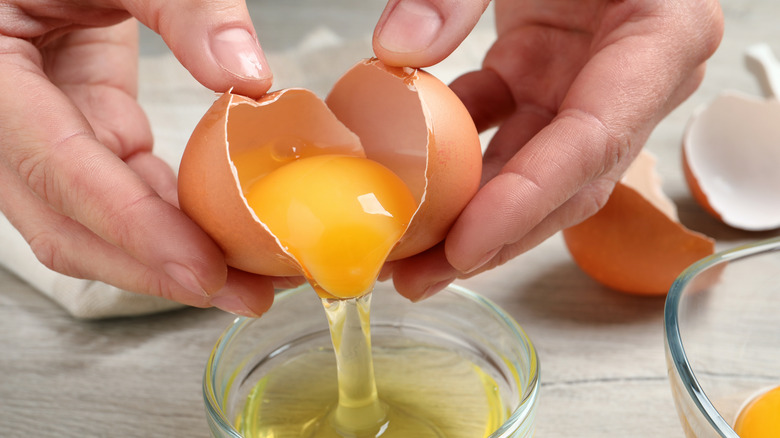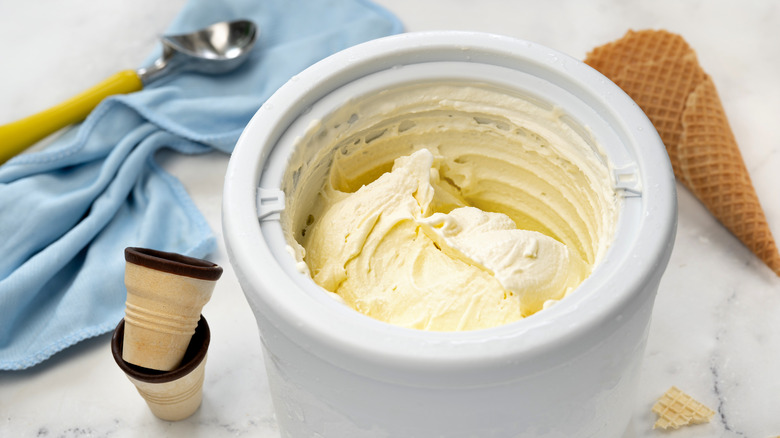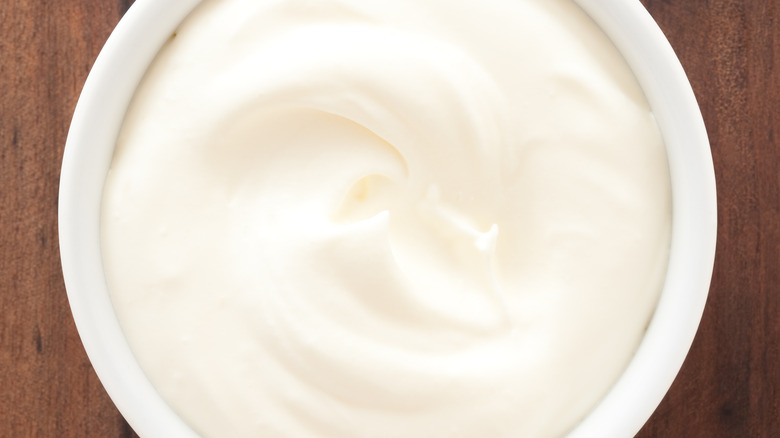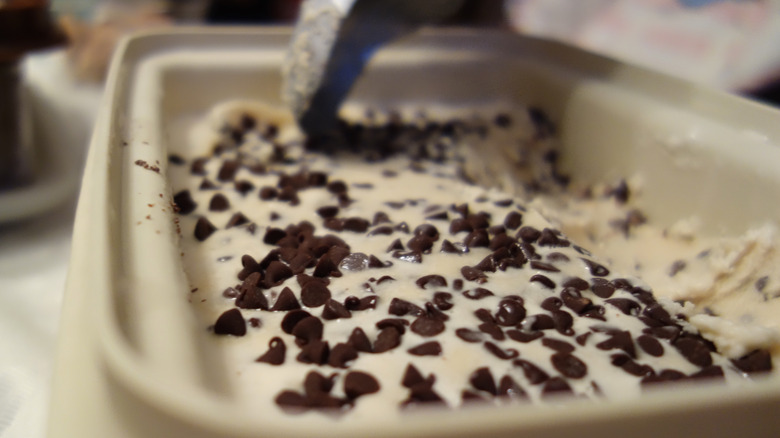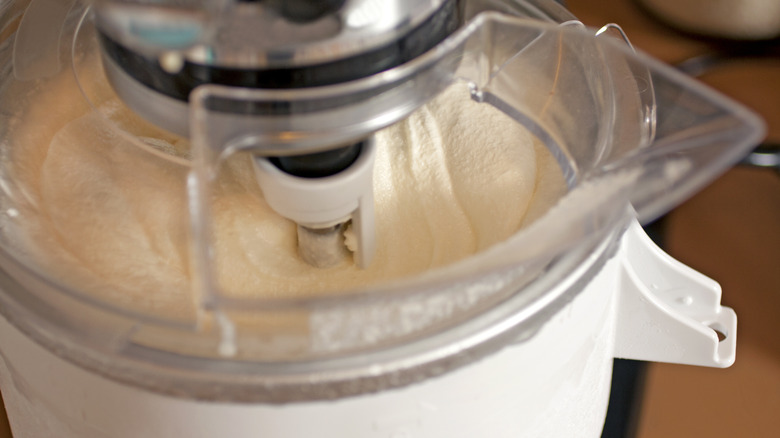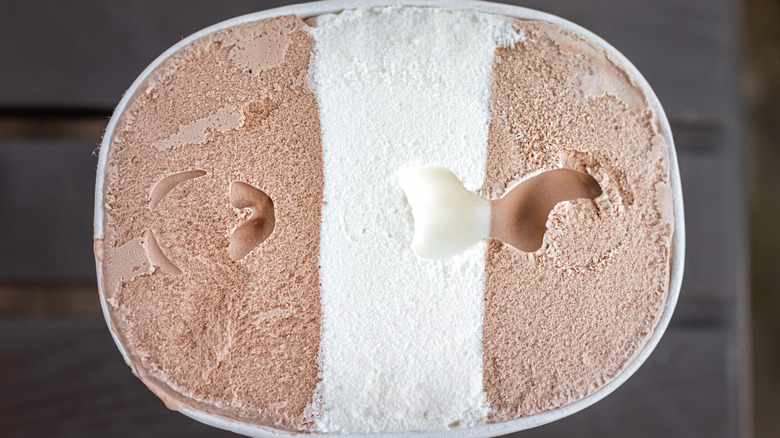14 Ice Cream Mistakes You Need To Avoid Making
We have yet to meet someone who doesn't like ice cream — and people have been liking this cold sweet treat for longer than you might think. The practice of mixing frozen liquids with sweet flavorings has been going on for thousands of years, with both Alexander the Great and the Roman emperor Nero said to be fans of snow mixed with juices and sweeteners. As time went on, culinary techniques and this basic mixture started to get more advanced. Dairy was introduced, and the earliest forms of ice cream as we know it appeared in the 17th century.
Once technology progressed enough for folks to be able to store cold items with ease, ice cream hit the mainstream. And today, you can even try lactose-free and vegan ice creams, opening up the dessert for folks with additional dietary requirements and making it something that pretty much anyone can enjoy. Ice cream remains by far the most popular accompaniment for desserts, with the majority of people who ordered a sweet course at dinner choosing it on the side, according to research conducted by Amore Di Gelato (per FoodBev Media). And it's just as popular on its own.
But whether you're buying it in a store, or making ice cream at home, it can be a food that's highly prone to mistakes. Whether it's how you're storing it or how you're making it, we've got all the key errors you should avoid.
1. Starting with low-quality ingredients
While some people are able to perform miracles in the kitchen with cheaper food items, it's generally true that our finished dishes are only as good as the ingredients we start with. And that's definitely the case with homemade ice cream. By using high-quality ingredients to make ice cream, you're ensuring that your food has the best flavor it can get. Low-quality ingredients, on the other hand, may leave your ice cream tasting flat or one-note and may affect its nutritional value.
While using good cream, milk, and sugar is vital to give your ice cream a good base, you'll likely notice using lower-quality ingredients most prominently when it comes to your added flavorings –- even in something as basic as vanilla. Pure vanilla extract may be pricier, but spending that few extra dollars will give your ice cream a way better flavor than a cheaper alternative. "The Baking Bible" author Rose Levy Beranbaum explained why the real thing leads to a better end result. "The taste of artificial vanilla varies from insipid to nasty. Pure vanilla not only has a delicious taste of its own; it also enhances other flavors," she told The Kitchn. Using pure vanilla extract is particularly important in ice cream. Because there's no heat involved, there will be no degradation of flavor, and so the vanilla taste will shine through more strongly than if it was cooked into a pie or cookie.
2. Forgetting to use salt
While ice cream is famed for its sweetness, adding salt is a vital step when making it. Salt has an effect on the freezing point of water. While water freezes at 0 degrees Celcius, ice cream needs to be colder than that to freeze properly, as dairy hardens at an even lower temperature. Therefore, by adding salt to the mixture, you effectively stop it from hardening at 0 degrees and lower the temperature that the water freezes at while the ice cream churns. All of this results in a smoother, more cohesive ice cream.
Adding salt to ice cream can also affect its taste in positive ways, making the dessert taste fuller and richer, and balancing the high sugar content with a savory element. It can also bring out the flavors of any additions you're throwing into the mixture. Just remember not to add too much salt to your ice cream. Not only will it ruin the flavor of the end product, making it taste too salty and overpowering anything else in the food, but it may also stop the ice cream from freezing properly.
3. Not allowing your base to rest
Making ice cream is not an instantaneous process, and those who are able to practice patience will be rewarded with a delicious end result. But as well as waiting for your ice cream to set in the freezer, you'll also need to let your base rest if you want the best dessert possible. Allowing your ice cream base to rest and chill stops larger ice crystals from forming during the churning process, as the mixture comes down to a super-cold temperature. This makes it into a smoother final product, resulting in a more enjoyable and tastier ice cream.
Resting your base also takes some of the strain off your ice cream machine, and is particularly important for units that can't get to super-cold temperatures. It's best to give your ice cream base sufficient time to rest in the fridge, preferably overnight, to ensure it's chilled throughout. For a slightly quicker result, place your base in an ice-water bath. Bear in mind, though, that failing to leave it for long enough may result in your base being an irregular temperature throughout, potentially affecting your final product.
4. Using low-fat dairy
Regular ice cream has a relatively high fat content, and this has led some people to seek out low-fat alternatives. But we would try to resist the temptation to use low-fat dairy when making ice cream at home. The butterfats in ice cream are incredibly important for a range of reasons, the first being that it gives you a creamier, richer taste and a smooth texture. Without the necessary amount of fat (which is usually about 10-20% of the composition of most ice creams), the dessert just doesn't have the velvetiness that makes it so delicious.
Butterfats also contribute to the composition of ice cream, not only making it firmer but keeping its structure for longer when it's served. It's worth remembering, too, that low-fat ice cream may not actually be that much healthier for you. Store-bought low-fat and low-calorie options can often compensate for the lower butterfat content with other additives, and you might find yourself having to do the same if you're trying to make it at home. And the assumption that an ice cream product is "healthier" for you might have an adverse effect on your behavior around eating it. "The Small Change Diet" author and registered dietitian Keri Gans told Chicago Health: "One of the biggest drawbacks of these types of ice creams is that many individuals rationalize because of the low calories they can eat more and lose sight of the actual intended serving size."
5. Storing it at too low of a temperature
When it comes to ice cream, the clue's in the name: It needs to be pretty cold. But it's entirely possible to go too far, temperature-wise. If you store your ice cream at too low of a temperature, it will harden too much, making it impossible to scoop and eat. This is a result of the higher number of water crystals in the ice cream freezing, making the mixture too tough. The hardness comes from an ice cream's density — the higher quality it is, the harder it will be to scoop at a low temperature, due to limited air being in the mixture. It's also worth bearing in mind that an ultra-cold freezer will take more energy to run, potentially costing you more money.
Ideally, your freezer should be set somewhere between 0 and -5 degrees Fahrenheit to keep ice cream at its optimum temperature. It's best served at a temperature slightly higher than that, which will make it softer and easier to scoop. If you've frozen your ice cream to too low of a temperature, the best thing to do is to let it warm up very gradually so that it doesn't melt and ruin your dessert. Place your carton of ice cream in the fridge and leave it there for about half an hour until it's soft enough to serve.
6. Forgetting to use a stabilizer
Making homemade ice cream isn't quite as simple as just mixing cream, milk, and sugar, putting it in the freezer, and hoping for the best. For a premium result, you'll likely need a stabilizer. Making good ice cream is all about getting the size of your ice crystals just right, as this will inform how smooth and creamy your end result is. Stabilizers work to stop ice crystals from growing too big by thickening the water content in the dessert, thereby allowing your ice cream to come together more cohesively and have a better texture.
The most common stabilizers in store-bought ice creams are usually a type of gum, either guar gum, carob bean gum, or cellulose gum. These are all natural derivatives, coming from plants, and usually take the form of a fine powder. Egg yolks can also work as a stabilizer and emulsifier. Bear in mind that if you're using gum in your homemade ice cream, a little can go a long way, and it's important not to overdo it. Ice creams that have too many stabilizers in them will develop a gummy, rubbery consistency. Always follow the recipe you're using very carefully, as once you add in a stabilizer and freeze your ice cream, it's very difficult to rebalance the mixture without ruining the whole batch.
7. Buying cheap ice cream
Ice cream comes in all different shapes and sizes and at multiple different price points. But try not to be tempted by the cheapest option on the shelf. Cheaper ice cream brands are generally able to keep their costs down because their products contain far more air than pricier alternatives. By pumping extra air into ice cream, manufacturers are able to make their products look bulkier without actually adding any extra ingredients.
Unfortunately, though, this has an impact on how far your ice cream stretches. Air-filled ice cream brands generally don't last as long as denser options. You can see this as the ice cream melts: Desserts that are more aerated will lose a large amount of their volume as the air escapes and disappears. It also has an effect on the taste. While all ice cream needs some air, products that have a higher concentration of ingredients will naturally have more intense flavors. It's generally advisable to trust your senses in the supermarket, and if you're debating between two similar flavors, go for the one that feels the heaviest in relation to its packaging size. The heavier ice cream is, the more actual cream it has inside it. Always keep an eye on your budget, though, and don't feel pressured to buy expensive ice cream if you like the cheaper stuff better!
8. Leaving out egg yolks
The best ice creams have a rich, dense consistency and a serious smoothness of taste. And one of the best ways to achieve that is by adding egg yolks to your mixture. Egg yolks are naturally high in lecithin, which is an emulsifier, helping to bring the ice cream mixture together and increase its creaminess. This is aided by the fat in the egg yolks, which increases the dessert's density.
The more egg yolks you use, the richer your ice cream will ultimately be. Egg yolks also help to stop ice cream from melting so quickly, and will help your mixture freeze better, no matter what else is in it or what your balance of other ingredients is. Bear in mind, though, that there's a delicate balance to be struck with egg yolks, and it's important not to overdo it in your recipe. The flavor of egg yolks can be pretty distinctive for some people, and in certain combinations and recipes, it can shine through quite strongly. This can be especially prominent if you heat your ice cream mixture to too high a temperature.
9. Overchurning your ice cream
While no-churn ice cream seems to be all the rage these days, churning is still an important step in many traditional ice cream recipes. The act of churning your ice cream mixture adds air, making it easier to scoop and giving it a lighter mouthfeel. It also stops the ice crystals in the mixture from getting too big, which can ruin the texture of the ice cream and make parts of it feel brittle.
But churning needs to be performed for the right length of time, and overdoing it can lead to some disappointing results. If you churn your ice cream too much, you alter the fat structure, and it all starts to stick together. This makes your ice cream mixture too dense and thick, and essentially starts to turn it into butter.
It's worth remembering that the amount of time you need to churn your ice cream can vary significantly from recipe to recipe, and may be affected by the balance of ingredients you're using. You can generally tell when it's finished by its consistency – when your ice cream starts to look like soft serve, with a slight density to it, it's usually done. You may also be able to tell by the sound of your machine: When it moves from a high-pitched to a low-pitched whirring sound, your ice cream could be good to go.
10. Forgetting to experiment with your flavors
One of the best things about homemade ice cream is that you get to put all the flavors you can't find in the store right into your own recipe. And so it's always a shame when people are unimaginative with their ice cream creations. The truth, though, is that ice cream has a relatively neutral base, and as such it's the perfect vehicle for sharper, sprightlier flavors that cut through the richness of the dairy.
One of our favorite additions to homemade ice cream is alcohol. Using a small amount of alcohol like rum or whisky can give your ice cream a boozy, nuanced flavor, and can enhance any other additions you make to it. Try pairing a small amount of rum with raisins or ginger, or a bourbon with chocolate chips or sharp berries.
Just keep in mind that when adding alcohol, a little goes a long way — and with ice cream, it can have a fairly pronounced effect on texture and its ability to freeze. Alcohol freezes at a lower temperature than water or dairy, so adding too much to ice cream will soften the overall mixture and stop it from solidifying properly. Adding a small amount, however, can make it easier to scoop.
11. Using whipping cream
Cream is an essential part of ice cream — it's in the very name of the dish, after all, so you'd expect it to play a pretty prominent role. But the type of cream you use is hugely important. One type to avoid is whipping cream, due to its lower fat content. While regular heavy cream has 36% fat, making it optimal for a smooth mouthfeel, whipping cream can have as low as 30%. Bear in mind that this fat content will come down further when you add your milk, and the overall fat level of your eventual ice cream mixture may end up too low.
Another issue is that whipping cream tends to react more to churning, and can end up firming up too much, with the mixture turning into butter too quickly. Whipping cream can also be more processed than heavy cream and contain additives and stabilizers that might alter the eventual texture of your final product. It's important, though, not to use a different type of cream than the one that your recipe calls for. Some recipes call for whipping cream and may balance things out by using less milk to achieve the best fat balance.
12. Mixing in your additional ingredients too early
While a classic, well-made ice cream requires little more than some well-chosen flavor additions and a spoon to eat it all up, others revel in their extra ingredients. Ice cream flavors like cookie dough and chocolate chip take regular ice cream and cram it full of chewy, crunchy, sugary bites, adding additional textures and flavors and making the act of eating it so much more appealing. Mixing in extra ingredients like raisins or nuts is also a great way to use up leftovers and small amounts of food items that you can't find another recipe for.
But you should never add your additional ingredients too soon. If you place them in your ice cream machine while the mixture is too thin, they'll sink straight to the bottom of the bowl and end up poorly distributed. Instead, wait until your ice cream has finished churning, and then mix in your items by hand. It's also advisable to chill your mix-ins in the freezer for a while before you add them in. If they're too warm, they'll bring up the temperature of your ice cream and potentially cause it to melt.
13. Forgetting to freeze your ice cream maker bowl
Many ice cream makers come with a removable metal bowl that the ice cream is churned in, and how you treat this is key to your dessert's success. These bowls need to be taken out of the machine and placed in the freezer for around eight hours or overnight before you make your ice cream. The bowl will often have a cooling liquid built into it, which will then freeze and maintain a steadily low temperature while the ice cream churns. If you don't do this, or don't freeze the bowl for long enough, your ice cream mixture simply won't be able to get cold enough to solidify properly. You'll end up with a soupy, liquid end result.
Ice cream makers that use freezer bowls are a common choice thanks to their relatively small size and affordability. It's useful to remember, though, that not all ice cream machines have a bowl attachment. Compressor machines, which are more commonly found in commercial settings, have built-in freezers, meaning that they require no preparation time before using them. These types of machines can be slightly pricier and may take up more space in your kitchen.
14. Storing your ice cream incorrectly
Whether you've made your own ice cream, or bought some at the store, it needs to be kept in your freezer. But exactly how you keep it in your freezer can make a big difference to its quality. When you take ice cream out of the freezer, its top layer starts to melt, and when it's placed back in, it can form ice crystals. These ice crystals can then contribute to freezer burn, with the ice cream losing its quality and taste.
A simple fix for this is to store your ice cream upside down. By doing this, any of the moisture on the top layer of the ice cream will drip down onto the lid, where the ice crystals will form — leaving the rest of the ice cream unaffected. Provided that you haven't left your ice cream out too long, the rest of the dessert will stay solid and won't melt down onto the top side of the container. If you have left your ice cream out for too long, or you don't entirely trust placing it upside down, try lining the top of it with parchment paper or plastic wrap before putting it back in the freezer. This protective layer will stop the moisture from evaporating and crystals from forming.
